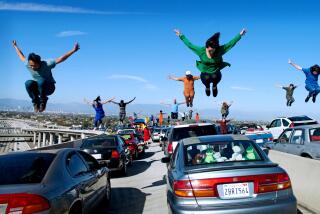His Work ‘Running’ Triathlon Allows Others to Do the Same
- Share via
A triathlon is a strange beast, a competitive mixture of primitive instincts first developed in a cave and modern technology developed in laboratories.
It is swimming and running, but it is also riding bicycles that weigh about the same as swim trunks or running shorts. And it is doing all these things in succession on the same morning.
Triathletes, thus, must also be rather strange, or at least unique, beasts. Bo Jackson can match them when he adds basketball as a hobby and finds a way to play for the Raiders, Royals and Rockets, all in the same day.
These people are athletic Sybils, awakening each morning to ponder which of their athletic personalities they should let out of their lockers. Should they swim or bicycle or run or all of the aforementioned?
Sunday morning is one of those days when they will do all three . . . and do them all at a race pace.
More than 1,000 such individuals will compete in the San Diego International Triathlon, which begins at 7 a.m. at Spanish Landing with a one kilometer swim, continues through Point Loma for 30 kilometers on bicycles and concludes behind Seaport Village after 10 kilometers of running.
Believe it or not, these people do not even bother packing lunches. In fact, the best will be done in time for brunch, completing all three disciplines in maybe 90 minutes.
Obviously, an operation like this must be run rather smoothly in a logistics sense. It isn’t like shooting a gun and turning 1,000 runners loose down Sixth Avenue. It’s a little more complicated when 1,000 athletes have to make the transition from water to wheels and then from wheels to running shoes.
“Once the last competitor is off the bike,” Rick Kozlowski said, “my day’s stress is cut down almost 100%.”
Kozlowski, 37 but looking maybe 28, is the race director . . . the guy who runs what all these people run in .
With the race only a couple of days away, it would seem likely that Kozlowski would be as frenzied as a triathlete trying to get off his bike and into his running shoes in like 15 seconds. He was instead a pleasant blend of enthusiasm and calm.
Yawn.
Old hat to Kozlowski, who is president of an event production company called Koz Enterprises. The boss is as casual as the company’s name.
“Once you do a triathlon,” he said, “you can do any other event.”
Indeed, once you do a triathlon, you could probably stage the Super Bowl. And this is the seventh San Diego International.
This particular triathlon happens to be the brainstorm of Kozlowski and Father Joe Carroll, who runs the St. Vincent de Paul Center downtown.
However, there were those who thought it a little hare-brained.
“People told us no way we’d get permits to do it downtown,” Kozlowski said. “We just had to decide what we could do that the race could live with and what we could do that the city could live with. We wanted to impact the city as little as possible.”
Even in the early hours of Sunday morning, the city cannot live with having 40 kilometers of streets tied up by people riding bicycles and running. The swim isn’t too bad, because it is only one kilometer long and doesn’t exactly take the participants into the paths of incoming aircraft carriers.
The bike portion winds in two loops through Point Loma and, according to Kozlowski, obstructs vehicular traffic only on sections of Canyon and Scott streets. The run portion is along the Embarcadero boardwalk.
“The major impact,” he said, “is on about 1,000 residents of Point Loma for about two hours. For a major event, that’s darn good.”
In fact, he said, this is the only metropolitan triathlon west of Chicago. It may not go through the heart of San Diego, but it makes a pretty strong run at its soul.
As might be expected, just getting ready for an event such as this is literally a juggling act.
“We have to deal with marketing and promoting and sponsors and logistics and permits and insurance,” Kozlowski said, running through what was probably an incomplete check list. “We throw all these balls into the air and hope we catch them all before they come down. An engineer could never do this, because engineers go from A to B to C. We have to deal with A through Z at once and hope it all comes out in the right order.”
Does it?
“There’s always something that goes awry,” he said, “and it might be something that was perfect the year before or all the years before.”
So you never know. You just hope the transition areas, where swimmers become cyclists and cyclists become runners, don’t take on the look of Grand Central Station at rush hour. You just hope the year’s biggest boondoggle is maybe a cone out of place.
That, of course, is why Kozlowski will be relieved when the last cyclist is on foot for that last leg.
Still, with the event only days away, Kozlowski was able to shrug his shoulders and smile and totally simplify this complex event known as a triathlon.
“I kind of look at it like I’m giving a party,” he said, “and invited 1,000 friends.”


